More and more companies and employees are shifting their focus on cultivating empathy in the workplace.
Why?
Well, based on the data from Businessolver’s 2022 State of Workplace Empathy:
- About 70% of employees and HR professionals believe that empathetic organizations drive higher employee motivation.
- Yet, only 69% of CEOs believe it’s their job to foster empathy in the workplace.
- Another 79% of CEOs say they struggle to be empathic.
- Furthermore, 77% of CEOs worry they will lose respect if they’re too empathetic — a 9% increase from 2021.
All things considered, it’s worth exploring how empathy can be encouraged and cultivated in any workplace. So, we’ll devote this blog post to:
- Defining empathic communication.
- Understanding the importance of empathic communication in the workplace.
- Examining some examples of empathic communication.
- Providing guidelines for improving empathic communication skills at work.
Table of Contents
What is empathic communication?
To understand empathic communication, you first have to understand empathy.
The term “empathy” first appeared in English in 1909 when it was translated from the German Einfühlung (empathy) by Edward Bradford Titchener.
Today, empathy is defined as “the ability to understand and share the feelings of another”.
In line with that, empathic communication is our ability to communicate to understand the other person’s feelings and empathize with the situation they’re in.
What’s more, Simon Sinek, the world-known British-American author and inspirational speaker, believes that empathy and perspective are the key aspects of strong leaders.
To further expand this definition and get a better understanding of what empathic communication actually is, I’ve reached out to a few experts to gain their insights.
Here’s how they defined empathic communication.
Definition #1: Empathic communication is about being fully present, listening consciously, and hearing deeply
For Sally Clarke, Co-Director at Human Leaders and Wellbeing and Burnout Researcher and Expert, empathic communication is easy to explain. She defines empathic communication as:

“Communicating with full presence and the conscious intention to listen, hear deeply, understand, and support the other — in such a way that they leave the interaction feeling heard and understood.”
In harmony with Clarke’s definition, Rob Volpe, CEO at Ignite 360, believes empathic communication is also about helping the person we are communicating with feel seen and heard:

“Empathic communication is when you are able to reflect to another person that you understand their point of view and are taking it into consideration. Providing that base level in Maslov’s hierarchy of needs creates a situation where the other person is going to be more receptive to what you have to say and can engage in a more meaningful way.”
Moreover, Volpe emphasizes the importance of understanding the two types of empathy:
- Cognitive, and
- Emotional.
The difference between cognitive and emotional empathy
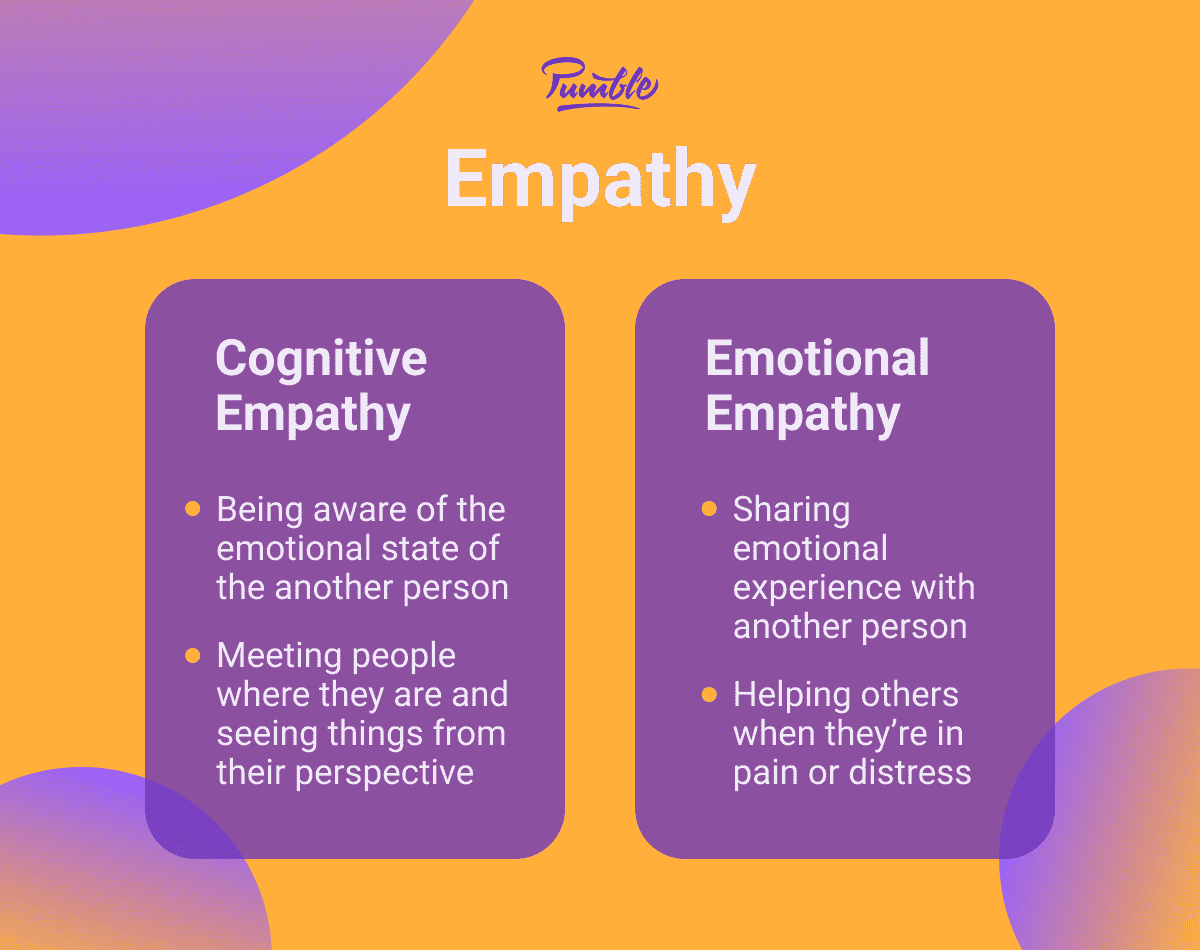
Cognitive empathy is being aware of the emotional state of another person. It allows us to meet people where they are and understand why they would be feeling sad or disappointed about something. It’s what enables us to see things from their shoes.
Emotional empathy is engaging with how others are feeling and sharing those emotions. It moves beyond cognitive empathy and allows us to share an emotional experience with the person. Thanks to emotional empathy, we’re more willing to help others when they are in pain or distress.
According to Volpe, both cognitive empathy and emotional empathy are important for helping us communicate better at work and in life:

“Emotional empathy is about feeling the feelings of others with them, while cognitive empathy is about seeing another person’s perspective or point of view. Cognitive empathy is what we use most often in the workplace and in our daily transactions.
I believe emotional empathy is more called upon with the people closest to us — best friends and family. Additionally, some people are uncomfortable or unable to open up emotionally or be able to process them easily. That scares them off from trying to be empathetic. Once they understand the cognitive side, that makes them more at ease with the idea of using empathy at work and in communication.”
Definition #2: Empathic communication is about the way a message is delivered
Considering that we’re trying to define empathic communication, it’s expected we talk about it in the context of the exchange of information between people or groups of people.
In step with that, Michelle Starr, CEO of Be Brown Brave LLC. defines empathic communication in the following way:

“Empathic communication involves verbal and written interactions between two groups or individuals that can sympathize with the pain or discomfort of one another.”
What’s more, Dominic K. Hawkins, Founder and Principal at Factotum Consulting, believes that empathic communication should also be focused on how a message is delivered, too:

“Empathic communication is the exchange of ideas or information that is based on understanding others’ emotions and perspectives.
It’s about the communicator putting themselves in their audience’s shoes and bringing compassion to their situation when imparting direction or news. Empathic communication involves emphasizing “how” a message is delivered, especially when it’s a difficult one.”
Definition #3 Empathic communication is communication with perspective and compassion
According to Alexis Zahner, Founder and Co-Director at Human Leaders, empathic communication equals communication with perspective and compassion.
She explains this in great detail:

“To be empathic is to deeply understand the perspective of another human being. To communicate empathically with others, we need to have the skills to step outside of our own perspective and into that of another: cognitively and emotionally, with compassion.”
Why is empathic communication important at work?
Businessolver’s report on workplace empathy revealed that even though organizations and leaders are taking steps toward creating a more empathic work environment, some are still struggling with putting theory into practice.
On the bright side, HR predictions for 2022 by the Josh Bersin Company show that the business world is slowly moving away from Business-centered leadership and embracing a more People-centered approach to leadership. This way, the role and importance of empathic communication become more evident, too.
💡 Pumble Pro Tip
If you’re looking to fine-tune your leadership skills, we have a leadership starter pack for you. Don’t miss to read some of our blog posts devoted to improving your leadership and communication skills:
Here’s what our contributors had to say on the importance of empathic communication at work.
Empathic communication creates a psychologically safe work environment
From Clarke’s point of view, empathic communication is what allows us to create a psychologically safe work environment. It’s what she finds essential for Human-centered leadership:

“Psychological safety is key to ensuring people are able to thrive at work, feel engaged with what they do at work, and feel connected to something larger than themselves through their work.
Empathetic communication is a core component of the lived experience of psychological safety: it imbues the day-to-day, moment-to-moment interactions we have at work with safety and respect.“
Empathic communication paves the way for constructive dialog
As Volpe sees it, the importance of empathic communication is reflected in its ability to create more opportunities for constructive conversations and avoid major conflicts in the workplace.
He says:

“Empathy enhances the skills that let us be the best person we can be or hope to become. Whether you are a leader, manager, team member, individual contributor, or volunteer, communicating with empathy helps people better understand and have a productive conversation rather than dissolve into an argument.”
Moreover, Volpe adds, engaging in communication with the aim of understanding and putting yourself in another person’s shoes is what facilitates positive communication and outcomes, in the long run:

“Rather than dig in your heels and justify your decision with ‘Because I said so,’ empathic communication is about putting information into terms that reflect an understanding and/or consideration of another person’s point of view. That relaxes people from a defensive posture and enables more open dialog which leads to more positive outcomes for all sides.”
Communicate effectively over Pumble
Empathic communication raises awareness about diversity at work
For Starr — who advocates for equal rights in the workplace — empathic communication is key to raising awareness about diversity and inclusion at work. It’s what ultimately leads to more compassion in the workplace, too.
In her words:

“This type of empathetic communication is essential at work because organizations and companies are comprised of employees that are many times diverse in age, tenure, experience, genders, ethnicities, nationalities, and abilities.
Having diverse groups requires awareness of commonalities, patience, and unconscious bias training with the willingness to show compassion to each.”
Empathic communication restores humanity in the workplace
One point of view that speaks volumes about the importance of empathic communication in the workplace comes from Hawkins. He reminds us that “we’re more than our title and function in the office” — i.e. that we’re all human:

“We’re all people with feelings and varying responsibilities beyond work, and you don’t know someone else’s situation. Using empathic communication skills helps bring humanity to someone else’s situation and the realization that they aren’t a machine just cranking out ‘TPS reports.’
With that perspective in mind, organizations can deliver news that’s least likely to foster resentment and negative feelings or even inspire and uplift workers.”
For Zahner, too, the human element is what makes empathic communication so important. It’s what helps us connect at a deeper level, she suggests:

“As human beings, we have an innate need to be seen and understood. Without empathy in how we communicate, we can’t truly connect and understand the world from the perspective of others.”
After reading expert insight you might think that achieving empathic communication is easy.
Yet, even though many of us tend to and want to communicate with empathy at work, sometimes it seems difficult or even impossible.
Let’s see what common barriers to empathic communication we can encounter.
💡 Pumble Pro Tip
Check out our guide if you need help improving your communication skills:
6 Barriers to empathic communication
In her Empathic communication companion guide, Elizabeth Morrison explains that empathic communication is good for our relationships with our family, friends, and co-workers, too.
She also makes a distinction between 5 different barriers to empathic communication.
They are:
- Lack of skills,
- Lack of time,
- Lack of focus,
- Bias, stigma, and judgment, and
- Anger.
In addition to these 5 barriers, we’ll also explore asynchronicity as another obstacle to empathic communication within the context of remote and hybrid teams.
Let’s explore each barrier a bit further.
💡 Pumble Pro Tip
Communication barriers are common obstacles that usually arise in a team and cause misunderstandings and miscommunication between communicators. Check out our guide if you need help overcoming barriers in communication:
Barrier #1: Lack of skills
Empathic communication is a skill that can be learned and perfected, just like any other. This means that we need role models we can look up to and mimic the way they communicate to be able to master any skill — empathic communication included.
Morrison analyzes the lack of skills barrier from a family perspective — explaining how many of us weren’t raised with a lot of empathic communication, even though we probably grew up in a loving environment.
So, to be able to master a certain skill, we need proper input from the people in our surroundings. In the circle of a family, empathic communication is harder to recognize and engage in when:
- Our parents and caregivers don’t ask for or value our opinion.
- Our family members have trouble apologizing to us.
- Everyone dismisses and ignores our feelings.
When we grow up in such an environment, it’s easy to slip into the same patterns when interacting with the people we work with, too.
In a workplace setting, the lack of empathic communication skills translates to:
- Not caring for our peers’ opinions and advice.
- Having trouble apologizing to our managers and teammates.
- Being dismissive and indifferent to our coworkers’ feelings and experiences.
Practice your empathic communication skills on Pumble
Barrier #2: Lack of time
Lack of time is probably the biggest obstacle, not only to empathic communication but also to everything else we want to do in life and at work.
The most recent remote work statistics show that employees working from home tend to work longer hours — which can make it difficult to find the time to nurture their so-called soft skills.
Now, despite all the scheduling and planning, sometimes we can overwhelm ourselves with tasks and lose control over our pace and time.
When this happens — when we are in a hurry or when we are spread too thin — our empathy decreases, Morrison notes.
And when it comes to situations like this at work, in communication, lack of time might also be manifested as rudeness, indifference, or dislike.
Barrier #3: Lack of focus
As Clarke stated, empathic communication is about being present and listening attentively.
So, when we’re out of focus or having trouble controlling the distractions in our surroundings, it can be challenging to fully commit to the conversation we’re having with our employees/managers.
In a remote setting, this can be even harder — considering the physical distance and time zone differences.
Remote communication is usually more asynchronous and sometimes even siloed — hindering our attempts at showcasing empathy in communication.
💡 Pumble Pro Tip
Staying focused and productive in a remote work environment can be challenging for some. We bring you 8 tips on being productive as a remote worker:
Barrier #4: Bias, stigma, and judgment
Bias, stigma, and negative judgment — i.e. the three old communication disruptors.
These barriers represent a group of negative thoughts about another person or a group of people. When our mind is clouded by these thoughts, our efforts to feel empathy for these people are hampered and we can find it hard to communicate empathically with them.
Bias, stigma, and judgment can be implicit and explicit.
- Sometimes, we can behave or communicate under the influence of implicit bias or stigma. This means that we aren’t aware of them and are interacting with people unconscious of bias and stigma.
- On the other hand, our behavior and communication can be influenced by explicit bias, stigma, and judgment — meaning that we’re totally aware of them and are choosing to rely on them in communication.
In Morrison’s view, empathy and judgment can be seen as a see-saw — when one side goes up, the other usually goes down.
Barrier #5: Anger
Another barrier to empathic communication can be anger.
No matter if we’re angry at our teammates or they are angry at us — in situations like this one, it’s hard to maintain high levels of empathy. This makes it easier to say the things we don’t mean and communicate in an ineffective manner with the people we work with.
Quite often, behind the anger, other emotions hide — hurt, fear, shame — which can prevent us from communicating with empathy in the workplace.
Barrier #6: Asynchronicity
In addition to the 5 barriers to empathic communication identified by Morrison, I would add another one to the list — asynchronicity.
Since more and more companies are operating under a hybrid, remote, or distributed work model, empathic communication can suffer when it’s not done in real-time.
In remote and hybrid teams, asynchronous communication is the preferred way of communication and it’s mostly done with the help of online collaboration technology.
However, empathic communication can be even harder to establish and maintain in the following situations:
- When the majority of communication is carried out through online collaboration tools such as business messaging apps.
- In time-pressing, delicate, or stressful situations that require handling and communicating in real-time or in person.
- When resolving conflict among remote employees.
- When managing a remote and cross-cultural team.
Need an asynchronous communication tool? Try Pumble
To understand better the difficulties of establishing and maintaining empathic communication at work, let’s take a look at some examples.
Empathic communication examples in the workplace
To paint a brighter picture of what empathic communication isn’t and what it is, let’s take a look at two examples.
Grace, a content producer at Lucky Five — a company specializing in software development — is about to break her deadline. Considering that she works in a hybrid team, she decides to send an instant message to her manager and explain the reason behind her being late.
This situation can play out in two distinct ways.
An example of no empathy in the workplace
In the first scenario, Grace reaches out to her manager for a deadline extension but she gets turned down in a very dismissive way.
Her manager doesn’t practice empathy in communication and that is clear from the response Grace gets from her.
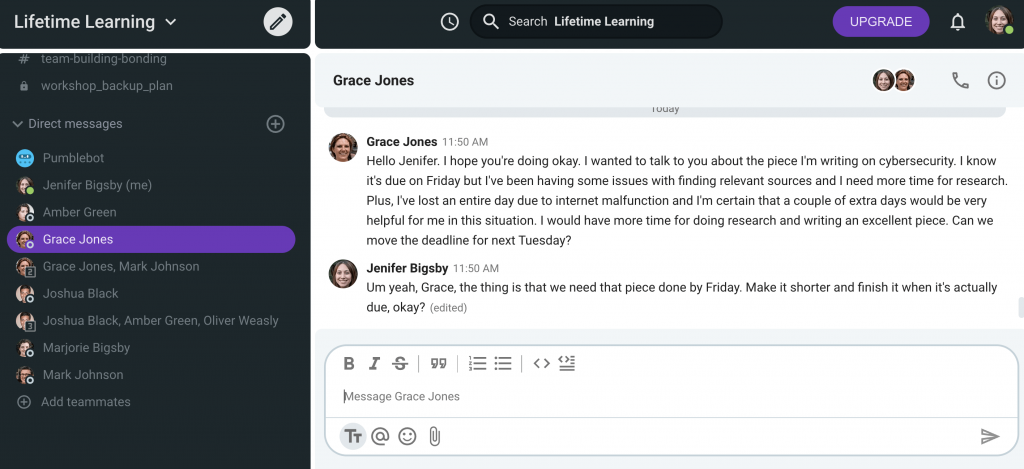
Connect with your coworkers on Pumble
This response is more likely to:
- Make Grace think her hard work and effort aren’t important or valued.
- Decrease her motivation and morale.
- Reduce the quality of her work.
- Make her lose interest in putting that much effort into her future tasks.
An example of good empathic communication in the workplace
In the second scenario, when Grace decides to reach out to her manager for a deadline extension, she faces understanding, compassion, and active listening — the pillars of empathic communication.
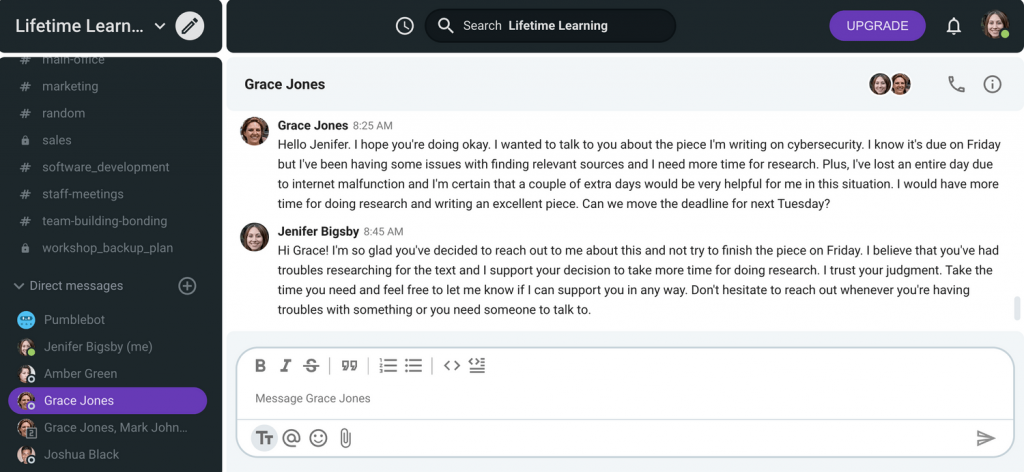
Build relationships with your coworkers on Pumble
When tinted with empathy, this response is more likely to result in:
- Employees feeling heard, appreciated, and understood.
- Better final outcomes.
- Increased employee engagement and morale.
- A stronger and more trusting relationship between managers and their employees.
💡 Pumble Pro Tip
Pumble is an instant messaging app that helps teams communicate more effectively and reduce the use of email in everyday communication. Check out the features and the pricing here:
13 Tips for developing empathic communication skills at work
In his article Six Habits of Highly Empathic People, Roman Krznaric says that empathy is actually in our nature. The newest research shows that human beings are “wired for empathy, social cooperation, and mutual aid”, he explains.
What’s more, we can nurture empathy throughout our lives, Krznaric continues — it’s what can help us make significant changes, both in life and at work.
Now, even though we often face barriers to empathic communication at work, there are steps we can take to overcome them.
Here are the 13 tips for developing empathic communication skills at work.
Tip #1: Be present with no agenda
In most cases, communicating empathically translates to simply being present and listening to what the other person is saying, Zahner notes.
Approaching a conversation as a tabula rasa and with no intentions in the back of our minds can help us communicate with more empathy, she believes:

“Slow down and lean in. Enter communication with the intention to be present with no prior agenda or expected outcomes. Listen to understand, even when what you’re hearing feels triggered or different from your own opinion — take a beginner’s mind to how you listen.”
Tip #2: Adjust your communication style
Different people communicate in different ways. This means they have different communication styles.
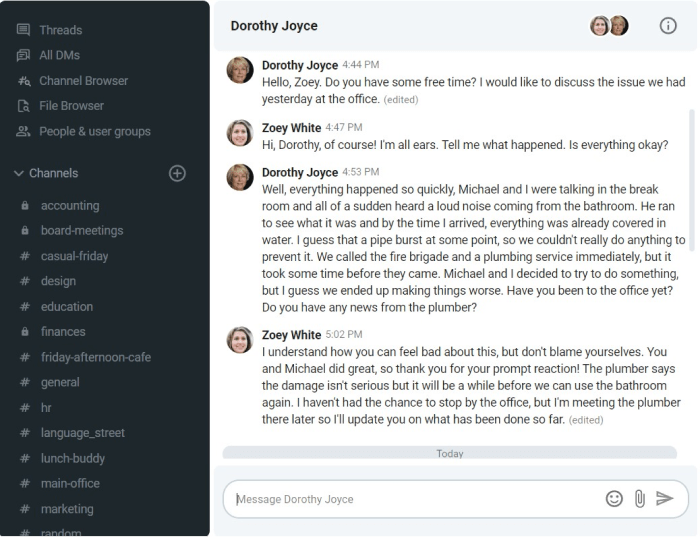
Why is it important to understand your communication style and that of your coworkers?
Being more aware of how you and the people you work with communicate can help you adjust your communication style according to the person you’re communicating with or to the situation you’re currently in.
Once you start paying more attention to how you and your teammates communicate, you will find it easier to put yourself in other people’s shoes and meet them where they are.
💡 Pumble Pro Tip
Sometimes, we have to communicate with difficult people at work, which isn’t easy. However, there’s a way to establish communication with difficult people at work and maintain a positive workplace atmosphere. Read more about that here:
Tip #3: Be curious and courageous
According to Krznaric, “highly empathic people have an insatiable curiosity about strangers.”
In a workplace setting, this insatiable curiosity isn’t aimed at complete strangers but coworkers — both from your direct team and other teams, too.
Clarke believes that bringing a curious mindset to work can help develop empathic communication skills quicker. The more people at work you’re curious about, the easier it will be to develop your empathic communication skills.
For example, the next time you’re talking with someone, try to move beyond workplace communication and start a conversation that will help you better understand the person you’re talking to.
Nurturing curiosity can help expand empathy and get a grasp on lives and worldviews that differ from our own.
Tip #4: Practice active listening
Effective communication isn’t just about speaking, presenting, sharing, etc.
It’s also about active listening and understanding what the other person is trying to say.
This is even more significant when it comes to communicating with empathy — active listening is the single most important thing you can do if you truly want to show the other side that you are present, that you’re listening, that you’re supportive… you get the picture.
In his book, Tell Me More About That: Solving the Empathy Crisis One Conversation at a Time, Volpe writes about the 5 steps to empathy. According to him, active listening is one of those 5 steps.
So, his advice is pretty straightforward:

“Be present and actively listen. Put the phone down, close the laptop, and focus on the person right in front of you.”
In an asynchronous workplace environment, employees should be trained to be better listeners.
A few practices that could help improve active listening in a virtual workplace include:
- Better message formatting to convey meaning and emphasize the importance of certain words or phrases.
- Using emojis (when appropriate) to showcase a certain tone and share your emotions easier and quicker.
- Engaging in one-on-one meetings with your teammates to show interest and support.
Tip #5: Acknowledge other people’s perspectives
For Volpe, integrating into understanding is another key step to empathy. This step requires us to make room in our heads for diverse points of view and different ways of doing things, he explains:

“As we are going through the first few steps in a conversation with someone, we often hear information that is contradictory to our way of thinking or that creates a dissonance that must be overcome. So this step is about accepting that there are differences and it doesn’t make them right or wrong.”
What’s more, integrating into meaning can be particularly important for managers trying to create an empathic work environment.
Yet, acknowledging your employees’ views doesn’t automatically mean you have to give up your own. Communicating with empathy requires us to remain open and curious to be able to understand our differences and support authenticity at work, too.
Volpe deconstructs this common misconception about empathy through an ice cream example:

“To make it simple to explain, I often use ice cream as an example. Let’s say my favorite flavor of ice cream is vanilla. Yours is chocolate. It doesn’t mean either of us is wrong, we just have a different preference or way of looking at the world of ice cream. If we remain in an open, curious state, we can learn a lot by asking more good questions about why you like chocolate ice cream and why I like vanilla.”
Once we’ve reached an understanding with the other person, we can move forward to make better decisions and come up with better solutions, Volpe’s final step to empathy suggests.
Tip #6: Don’t be afraid of overcommunicating
In a virtual work setting, leaving things unsaid or unexplained can have a detrimental effect on our ability to communicate and act empathically with our team members.
Yet, there’s a way to not let things slip under the radar — overcommunication.
Sometimes, we can struggle with interpreting our teammates’ messages properly, which can create more confusion and misunderstanding. By overcommunicating — communicating more and often — we can become more understanding of our teammates’ ideas, desires, fears, etc.
And, if you’re truly communicating with the aim of understanding, you can even try to paraphrase the other person’s words, Clarke suggests:

“When appropriate, share back what you’re hearing the person share — to ensure you’re understanding. Use their words.”
Tip #7: Implement the 5 Chairs Method
In one of her TedTalks, Louise Evans, a behavioral coach and corporate trainer, talked about the theory of 5 Chairs. Evans’ starting point is that we can’t always know the reason behind other people’s or our own behavior.
This is a good exercise for everyone who wants to fine-tune their empathic communication skills and communicate more emphatically with other people.
The idea behind the 5 Chairs Method is to not jump to conclusions and use multiple lenses (chairs) to examine the entire situation, the people, the behaviors, etc.
The 5 Chairs include:
The Red Chair — Attack: When we’re in this chair, we usually complain, judge, blame, and gossip. We’re always right and don’t give room for explanations or justifications.
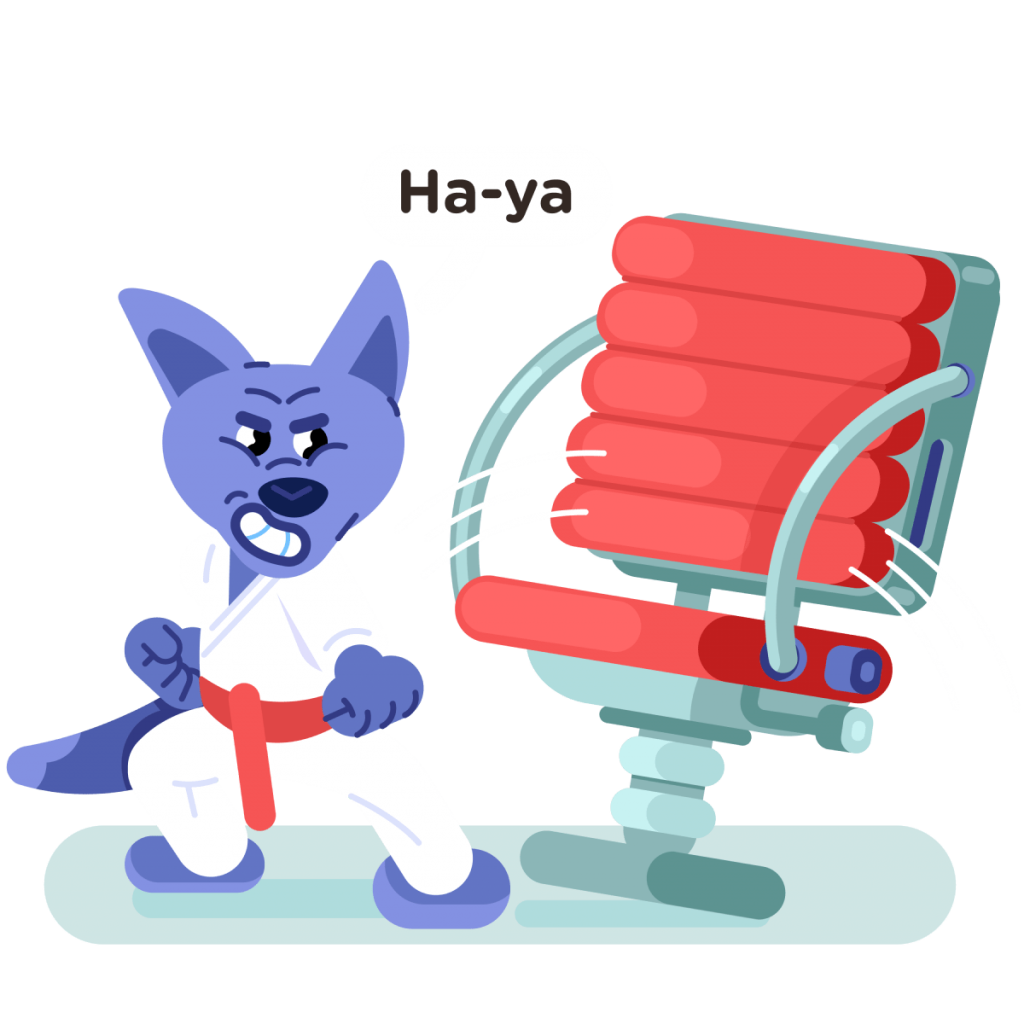
The Yellow Chair — Self-doubt: We often feel vulnerable and unlovable in this chair — we judge ourselves, playing the victim. We’re terrified of rejection, disappointment, and being weak.
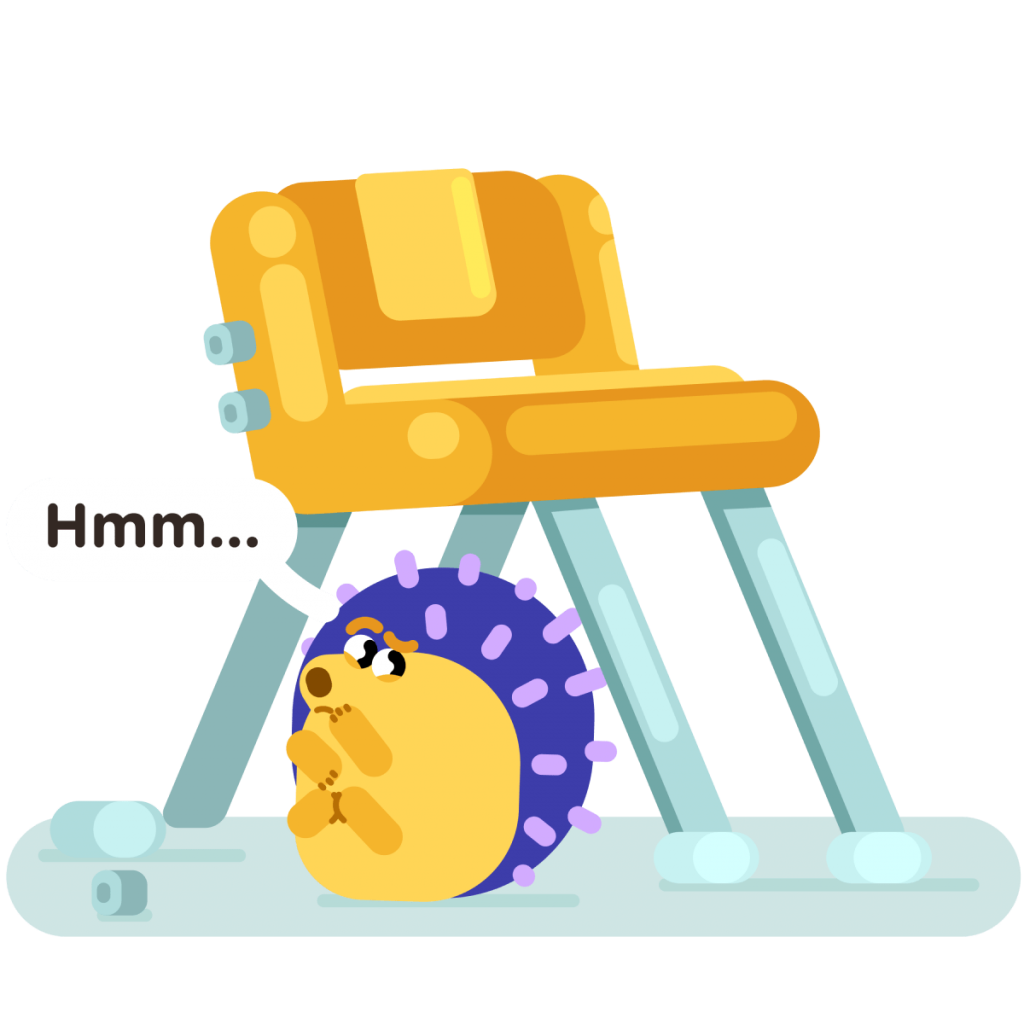
The Green Chair — Wait: In this chair, we are aware, mindful, observant, conscious, curious, etc. We are interested in knowing why other people are angry or sad.

The Blue Chair — Detect: In this chair, we become detectives of ourselves. We practice self-awareness, fearlessness, assertiveness, and freedom. We’re capable of creating boundaries — we know what we want and where we’re headed.

The Violet Chair — Connect: In this chair, we are empathic, tolerant, compassionate, caring, and understanding. We listen to people, we’re present and generous. We embrace diversity and other people’s realities. We are here to connect deeply.
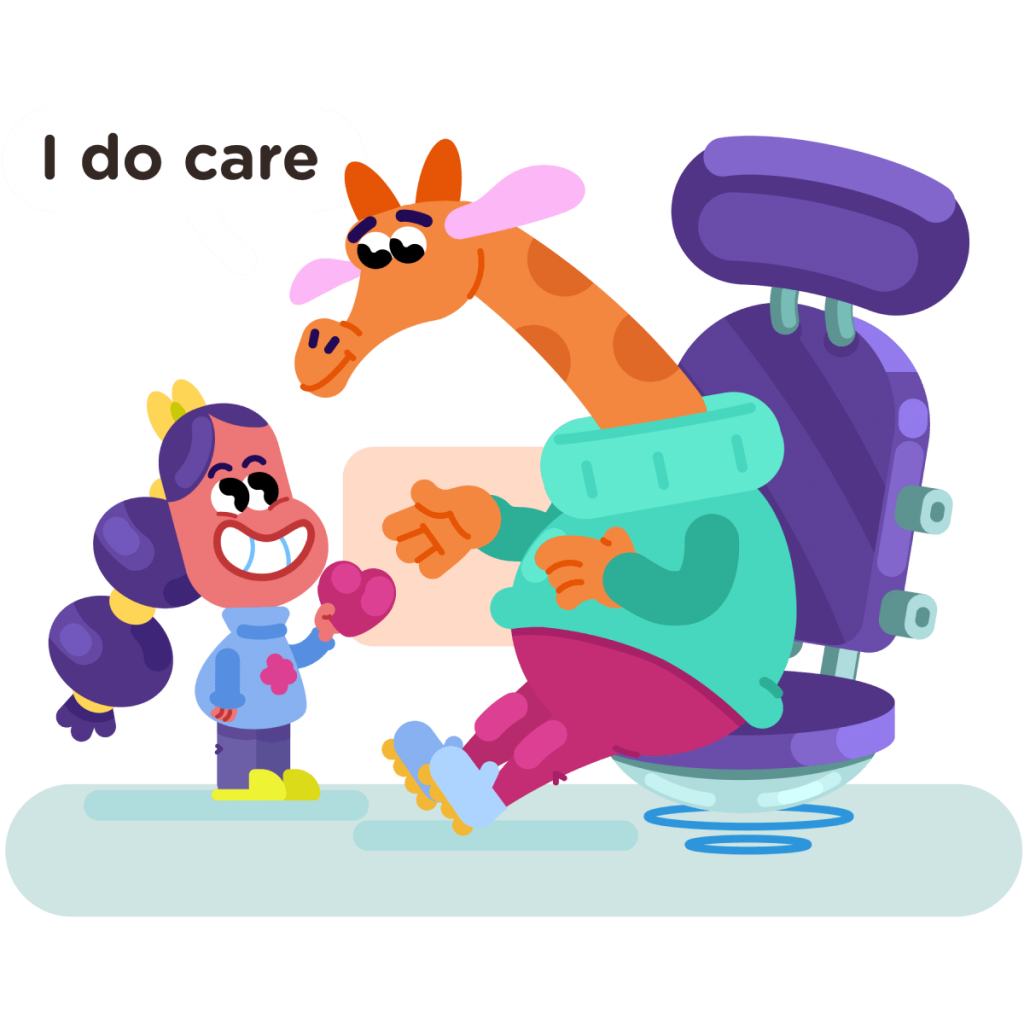
According to Evans, the key to better communication is knowing how to balance these 5 chairs and implement them in different situations and with different people.
In each situation, we can choose which chair to sit in — but the one that supports empathy in the workplace and in life the most is the Violet one.
Tip #8: Mind the generational gap
Most companies now employ people from different generations:
- Silent Gen,
- Baby Boomers,
- Gen X,
- Millennials, and
- Gen Z.
This can make it harder to communicate and find a common ground — especially when people have been raised in different social and economic backgrounds.
A Baby Boomer and a Gen Z might have different perspectives on workplace communication — but they still have to work their way to understanding and making progress.
Hawkins believes that organizations and employees should take time to understand other perspectives and personas:

“With 5 generations in the workplace, each bringing their own ways of working, their own problems, and worldviews, our colleagues are more diverse than ever.”
Moreover, Hawkins also vouches for authenticity and transparency for better empathic communication among different generations at work. He believes that’s what paves the way to trust and effectiveness overall:

“Individuals should pause before sending that nasty gram starting with ‘per my last email’ and leaders should strive for authentic interactions, and even ask for feedback to increase transparency in the relationship. Empathy between all levels of an organization can boost trust and improve functionality overall.”
Once there’s more understanding between people coming from different generations, empathic communication will become easier to maintain, too.
Make communication easy, no matter the generation — with Pumble
💡 Pumble Pro Tip
Establishing effective communication among different levels of an organization can also be challenging. Check out our texts for more information on improving communication in your company:
Tip #9: Embrace diversity
In line with minding the generational gap, embracing diversity is another good way to support and improve empathic communication in the workplace.
Based on data from Glassdor’s Diversity & Inclusion Workplace Survey, 76% of employees and job seekers say that a diverse workforce is an important factor when evaluating companies and job offers.
So diversity and inclusion support empathic communication at work, among other things.
Here’s what Starr advises us to do to make room for more diversity and empathy at work:

“Initiate contact with someone that’s different from your group, include each other in meetings or conversations, give credit to each other when deserved, celebrate efforts from groups that are typically underserved, engage in interactions, and extend invites.”
Tip #10: Do away with judgment
As Volpe writes in his book, the first step in the process of achieving empathy and empathic communication is dismantling judgment.
What does this mean?
Volpe explains:

“This is about being judgmental and casting aspersion. We all do this, but it forms a brick wall that prevents us from getting to a place of empathy, let alone communicating empathically.”
To make sure our judgment, decision-making, and communication aren’t blurred by bias or stereotypes, Volpe recommends practicing awareness and listening without judgment:

“Be aware of biases and stereotypes that you have.
Use that awareness to hit the pause button and listen without judgment.
And, have grace and forgiveness with yourself. It’s just as important to make the effort as to get it right.”
Consistent with Volpe’s advice, Clarke suggests that effective communicators should allow the other person to share their truth freely, too:

“Hold space for the other person’s truth: listen, without judgment.”
Tip #11: Ask good questions
Remember the insatiable curiosity we mentioned earlier?
It’s usually based on asking good questions.
As Zahner sees it, asking questions is one of the best ways to cultivate empathy and scratch beneath the surface:

“Often we struggle to cultivate empathy because we bring ‘already knowing’ or a sense of ‘right and wrong’ to communication. Asking questions helps bring to the fore underlying motivations, struggles, and emotions of others.”
In addition to asking the right questions, Clarke recommends checking in with the person after the initial conversation. As she explains, that’s what makes people feel recognized and cared for:

“Keep asking open questions and checking in with the other person that you’re understanding correctly until you get a deep sense of having heard the person’s truth and them feeling heard and understood.”
On the other hand, Volpe thinks we should steer clear of questions that only affirm our biases:

“When communicating, ask open questions that are exploratory. Remove the word ‘why’ from your vocabulary. It puts people on the defensive. Use ‘how’, ‘where’, ‘when’, and ‘who’ to rephrase the questions. And, when someone has answered and you want to know more, use an open follow-up like ‘Tell me more about that.’”
On another note, knowing where to draw the line with question-asking is also important — your goal should be to get closer to the person you’re talking to and create a safe space where they can share their thoughts and experience without being judged.
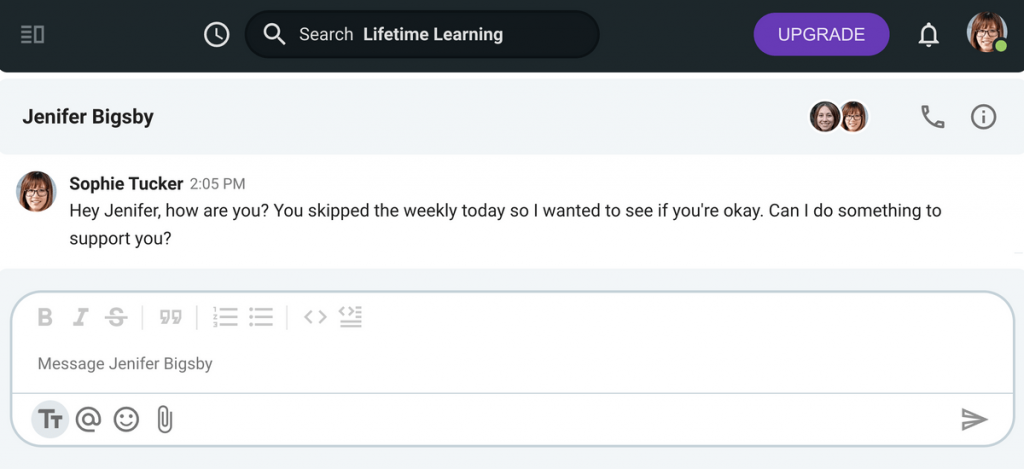
💡 Pumble Pro Tip
If you struggle with asking better questions at work, don’t miss to read our text and learn how to master this skill:
Tip #12: Give advice only when asked
Another important thing to have in mind when trying to practice empathic communication is that you should focus more on understanding and acknowledging what your team member or manager is saying.
Furthermore, you should avoid responding, comparing the situations, or giving advice — unless you’re asked to do it.
As Clarke sees it, it’s best that we ”resist the temptation to share our own experience or compare.” What we should do more is LISTEN, she proposes.
In a setting where you’re geographically distant from your teammate, make sure to use your workplace chat app to your advantage and make sure you’re creating a safe space for them to share what is troubling them.
In essence, communicating with empathy should be nurtured despite the physical distance or a difference in time zones.
Tip #13: Cultivate compassion and acceptance
When conversing with the members of your team, you should make sure to try and showcase compassion and accept people for who they are. This will bring you closer to communicating with more empathy, Zahner notes:

“Bring compassion to yourself and others. By cultivating a deep sense of self-compassion and acceptance of who we are, we’re better positioned to accept others compassionately for who they are, too.”
She recommends perceptual repositioning as the best way to foster compassion and acceptance:

“Take time to truly step outside of your own shoes and experiences to imagine what it may feel like and look like from the perspective of another.”
In line with Zahner’s advice, Clarke shares what types of questions we can use to reinforce that compassion:

”To bring in compassionate empathetic listening, add a question like this:
‘What do you need right now?’ or
‘What can I do to support you right now?’”
—
There’s a lot you can do to work on your empathic communication skills, just take your time.
Empathy takes time.
And if you’re struggling with finding the right words to express empathy, we’ve prepared that for you, too.
20 Phrases to express empathy at work
Clarke already mentioned what type of questions we should ask to show that we truly care and want to help.
But, since expressing empathy in communication can be hard for some people, we’ve compiled a list of 20 phrases and questions that can help improve your empathic communication skills at work:
- I understand how you feel.
- This must be hard/easy/great/important for you.
- This is a really challenging time/task/project for you.
- I totally agree with you.
- I’m on your side.
- What can I do to help you?
- Is there anything I can do for you?
- How are you feeling about this?
- I’m sorry you had to experience that.
- That would have disappointed me, too.
- I’m happy that you’re making progress with that task/project!
- You are doing great.
- Thank you for sharing this with me.
- Let me summarize. What you’re saying is….
- I would be thrilled for you.
- What are you planning to do about this?
- What has this situation/project/task been like for you?
- What have you been struggling with?
- If there’s anything I can do to help, let me know.
- Your sadness/happiness makes total sense to me.
💡 Pumble Pro Tip
Effective business communication might be hard to establish and maintain. Check out the dos and don’ts of business communication in our two blog posts:
Final thoughts: Empathic communication is the key ingredient of thriving workplaces
Businessolver’s 2022 State of Workplace Empathy Report revealed that about 69% of employees say their organizations are empathetic — a drop from 72% in 2021.
Also, the number of employees seeking mental health support at work has increased from 32% in 2020 to 41% in 2022.
This indicates that for companies and organizations to thrive, they need to invest more in cultivating and living empathy in the workplace.
Thanks to our amazing contributors, we’ve managed to learn what it means to communicate empathically and why that’s important — not only at work but in life, too.
Hopefully, after reading this blog post, you’ll reexamine the state of workplace empathy in your organization and use the tips gathered here to improve it.
Remember that empathy is a learnable and practicable skill. The more you engage in empathic communication, the better you’ll be at it.
It’s never late to start!










